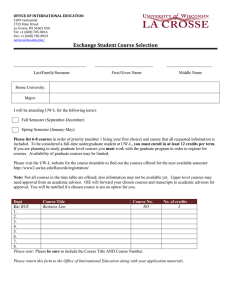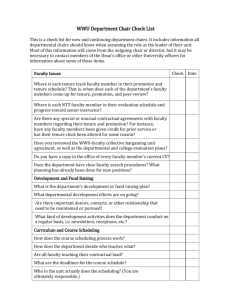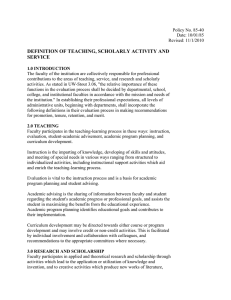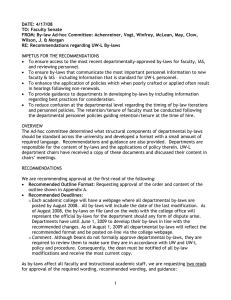UW-L By-laws (4-15-08) A B
advertisement
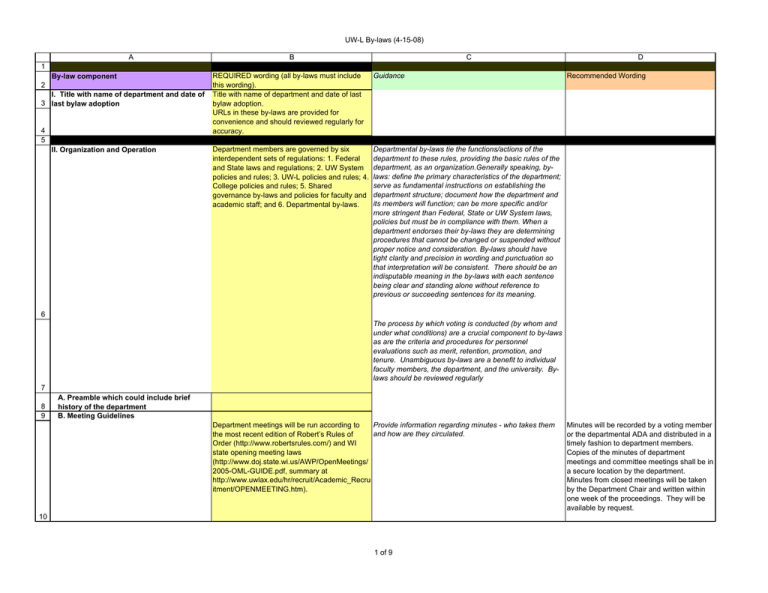
UW-L By-laws (4-15-08) A B C D 1 By-law component 2 I. Title with name of department and date of 3 last bylaw adoption 4 5 II. Organization and Operation REQUIRED wording (all by-laws must include this wording). Title with name of department and date of last bylaw adoption. URLs in these by-laws are provided for convenience and should reviewed regularly for accuracy. Guidance Department members are governed by six interdependent sets of regulations: 1. Federal and State laws and regulations; 2. UW System policies and rules; 3. UW-L policies and rules; 4. College policies and rules; 5. Shared governance by-laws and policies for faculty and academic staff; and 6. Departmental by-laws. Departmental by-laws tie the functions/actions of the department to these rules, providing the basic rules of the department, as an organization.Generally speaking, bylaws: define the primary characteristics of the department; serve as fundamental instructions on establishing the department structure; document how the department and its members will function; can be more specific and/or more stringent than Federal, State or UW System laws, policies but must be in compliance with them. When a department endorses their by-laws they are determining procedures that cannot be changed or suspended without proper notice and consideration. By-laws should have tight clarity and precision in wording and punctuation so that interpretation will be consistent. There should be an indisputable meaning in the by-laws with each sentence being clear and standing alone without reference to previous or succeeding sentences for its meaning. Recommended Wording 6 The process by which voting is conducted (by whom and under what conditions) are a crucial component to by-laws as are the criteria and procedures for personnel evaluations such as merit, retention, promotion, and tenure. Unambiguous by-laws are a benefit to individual faculty members, the department, and the university. Bylaws should be reviewed regularly 7 8 9 A. Preamble which could include brief history of the department B. Meeting Guidelines Provide information regarding minutes - who takes them Department meetings will be run according to and how are they circulated. the most recent edition of Robert’s Rules of Order (http://www.robertsrules.com/) and WI state opening meeting laws (http://www.doj.state.wi.us/AWP/OpenMeetings/ 2005-OML-GUIDE.pdf, summary at http://www.uwlax.edu/hr/recruit/Academic_Recru itment/OPENMEETING.htm). 10 1 of 9 Minutes will be recorded by a voting member or the departmental ADA and distributed in a timely fashion to department members. Copies of the minutes of department meetings and committee meetings shall be in a secure location by the department. Minutes from closed meetings will be taken by the Department Chair and written within one week of the proceedings. They will be available by request. UW-L By-laws (4-15-08) A C. Definitions of Membership & Voting Procedures B C Make sure to define the criteria by which departmental membership and voting rights are determined. It is best when the criteria is as "stable" as possible - such that a department need not have to frequently determine who is a voting member. All ranked (tenure-track or tenured) faculty should vote and there should be a criteria to guide whether IAS or non-insturctional academic staff are also voting members of the department. D Sample Wording: Members of the department are defined as instructional academic staff members with a 50% contract, non-instructional academic staff members with 100% appointments, and all ranked (tenure-track or tenured) faculty (including those on leave or sabbatical who are in attendance) for the purpose of conducting business at any regular meeting. 11 Majorities are often referred to as "simple" indicating 50% or more, alternates are "majority +1" or a "super majority" defined as 2/3rd or in very rare conditions ¾. Departments often hold to a super majority for personnel decisions. However, departments may wish to consider a higher quorum standard rather than a higher majority standard for personnel decisions. The wording should explicitly address proxies. Normally, experts recommend against proxies. The wording should indicate whether the voting majorities are of those present or those voting (those voting is recommended). The wording should indicate the type of acceptable voting. If a paper ballot is allowed – they must be signed and kept securely for seven years. Robert’s Rules indicates that abstentions do not affect the voting outcome (they are non-votes). Late or non-received ballots, a non-response to a vote, or improperly marked ballots shall be treated the same as a non-vote and should not be counted in determining the vote. In addition, abstentions and blank votes are treated as non-votes and are ignored. For example, if 20 ballots were cast with 2 voting yes, 1 voting no, and 17 abstaining, the motion would pass. Abstention votes in retention, promotion, or tenure matters are discouraged except when a conflict of interest exists or the voter has no or little knowledge of the person being considered. 12 13 Unless specifically indicated otherwise, a simple majority of those voting carries the vote. Voting occurs with a voice vote or a hand vote and any member can call for a roll call vote. Proxy voting is not allowed. Members who join by teleconference and have heard all the deliberation are eligible to vote. 14 Bylaws sometimes specify something like "a majority of the members present" or "a majority of the tenured or ranked faculty" for certain motions. In such cases, there is a precise number needed to pass, so blank ballots, nonvotes or abstentions have the effect of being a negative vote. These types of provisions are discouraged because they can present difficult legal issues if ballots are late, non-received or if faculty chose to be absent or do not vote. 15 A quorum for the purpose of conducting business at any department meeting shall be a simple majority of the persons eligible to vote. For personnel meetings a quorum is achieved with 2/3 of those eligible to vote. D. Definitions of Quorum and Majority 16 2 of 9 UW-L By-laws (4-15-08) A B C E. Changing by-laws 17 18 19 III. Faculty/Staff Responsibilities A. Faculty Departments should delineate additional responsibilities. Faculty responsibilities are referrenced in section IV of the Faculty Senate by-laws entitled "Responsibilities of Departments, Department Members and Department Chairpersons." A complete set of the by-laws are available off the Senate webpage under "Senate Articles and Bylaws" http://www.uwlax.edu/facultysenate/. 20 B. Instructional Academic Staff Responsibilities and Expectations Requests for IAS hiring will be presented to the Departments should delineate the types of duties/activities associated with workload equivalencies for IAS. The college dean. The request will indicate one of guidelines adopted by Faculty Senate provide some the standard titles from the lecturer or clinical general guidance. professor series (http://www.uwlax.edu/facultysenate/committees/ ias/pages/titling.html) and will outline specific duties including teaching and any additional workload. Total workload for IAS is defined as a standard minimum teaching load plus additional workload equivalency activities. (http://www.uwlax.edu/facultysenate/41st/3-2907/IAS%20Appendix%20B.htm). 21 C. Non Instructional Academic Staff Responsibilities and Expectations 22 Departments should clearly delineate the types of duties/activities of non-instructional academic staff members. 3 of 9 D These by-laws may be amended by the following procedures: A two-thirds majority of the current department membership present and eligible to vote on by-laws is required to amend the by-laws; Any proposed amendment(s) shall be presented and distributed in writing at a department meeting and voted on at the next subsequent meeting; policies pertaining to personnel issues, which are the responsibility of the ranked-faculty (tenure-track or tenured), or of the tenured faculty may only be changed by those voting. Second readings can be waived for by-laws that do not pertain to personnel decisions. UW-L By-laws (4-15-08) A D. Student Evaluation of Instruction* B The department will follow the UW-L SEI policy and procedure available off the Faculty Senate webpage http://www.uwlax.edu/facultysenate/. Ranked Faculty & SEIs. Results from the Faculty Senate approved SEI questions are required for retention, tenure, and promotion in the form of (1) the single motivation item and (2) the composite SEI consisting of the 5 common questions. These numbers will be reported using the Teaching Assignment Information (TAI) form. The department will add both the motivation item and the composite SEI fractional median for each course. In addition, the candidate's overall fractional median for the term on both the single motivation item and the composite SEI are reported. Finally, the department adds the departmental fractional median for both the single motivation item and the composite, the minimum and maximum composite SEI for the department, and the candidate's rank in SEI scores relative to all departmental ranked faculty (tenure-track or tenured) for that term (e.g. 3 of 15). C Departmental student evaluation of instruction items. If a department utilizes additional questions in the evaluation of teaching describe here. For IAS, departments should clarify the composition of the SEI comparison group for IAS (the department as a whole as a comparison group is recommended). D Evaluation for the purposes of merit is described in the faculty handbook on the HR webpage under "FACULTY EVALUATION PROCEDURES; Adopted by the Faculty Senate, 4/7/7." The first line reads "Distribution of merit compensation shall be determined by the individual departments or functional equivalents according to their bylaws and/or other departmental rules and regulations. Each department shall specify its procedures for appeals of merit decisions with a time limit set prior to the date the department reports evaluations to the dean." By-laws should clearly address procedures for determining merit increases for all Redbook positions (such as first year hires). All faculty and IAS have a June 1st deadline for entering teaching, scholarship, and service activities into the electronic portfolios system (Digital Measures) on activities from the prior year June 1st – May 31st. 23 IAS renewal and career progression. The same information as above is reported; however, no TAIs are generated for IAS. 24 25 IV. Merit Evaluation (Annual Review) 26 27 28 29 30 The results of merit reviews for all ranked faculty who have completed at least one academic year at UW-L are due to the Dean's Office on Dec. 15 annually. Merit reviews reflect actitivites during the prior academic year ending June 1. A. Evaluation Processes & Criteria 1. Faculty 2. Instructional Academic Staff (if included in merit processes, otherwise see VI). 3. Non-Instructional Academic Staff (if included in merit processes, otherwise see VII). 4 of 9 UW-L By-laws (4-15-08) A 4. Department Chair (if applicable) 31 32 33 34 B C B. Distribution of Merit Funds C. Appeal Procedures (if applicable) V. Faculty Personnel Review 35 The department will follow the policies regarding retention and tenure described in the Faculty Personnel Rules (UWS 3.06 - 3.11 and UWL 3.06 -3.08) http://www.uwlax.edu/HR/F_Handbook.htm. Tenure/retention decisions will be guided by the criteria established in the by-laws at the time of hire unless a candidate elects to be considered under newer guidelines. The criteria outlined in Section V. A & V. B. "Faculty Personnel Review" in these by-laws should be applied to faculty with a contract date after [INSERT DATE]. 36 The department will follow policies guiding parttime appointments for faculty and tenure clock stoppage available on the Human Resources website. 37 38 39 A. Retention (procedure, criteria and appeal)* Be sure to describe an additional materials in sufficient i. Faculty under review provide an detail. electronic portfolio related to their teaching, scholarship, and service activities extracted from their date of hire to date pf review. Hyperlinked syllabi are required and the candidate may choose to provide additional evidence. Additional materials may be required for departmental review and will be indicated in these by-laws. Departments will provide the following ii. materials to the dean: 1. Department letter of recommendation with vote; 2. Teaching assignment information (TAI) datasheet that summarizes the courses taught, workload data, grade distribution and SEIs by individual course and semester (which are only available after completing a full academic year) and departmental comparison SEI data; and 3. Merit evaluation data (if available). 40 The initial review of probationary iii. faculty shall be conducted by the tenured faculty of the appropriate department in the manner outlined below. 41 Indicate the manner in which departments will conduct the review. Departments should ensure a process that allows all tenured members to carefully review candidate portfolios. All tenured faculty must serve. If the department does not have at least three tenured individuals, a committee of at least three is recommended comprised of tenured faculty from a closely aligned discipline. 5 of 9 D UW-L By-laws (4-15-08) A B iv. Starting with tenured-track faculty hired effective Fall 2008, all first-year tenure-track faculty will be formally reviewed in the spring of their first year. A departmental letter will be filed with the Dean and HR. Formal reviews resulting in contract decisions will minimally occur for tenure-track faculty in their 2nd, 4th and 6th years. C One of the most common concerns voiced by junior faculty nationally is a lack of clear criteria regarding retention, tenure and promotion. Clear expectations are a benefit to the department and its faculty. Non-retention decisions (including tenure) should not be a "surprise" to the candiate. Formal communication with the candidate regarding his/her progress should include specific references to concerns raised about performance. 42 The granting of academic tenure represents a long-term commitment of institutional resources which requires proof of excellence in past performance and a forecast that an individual faculty member's intellectual vitality and future contributions will continue to be of high quality for many years to come. (From Mentor in a Manual: Climbing the Academic Ladder to Tenure, by A. Clay Shoenfeld and Robert Magnan. Magna Publications, 1993). By specifying in writing the usual criteria for advancement - teaching, scholarship, service - a university does not thereby set objective criteria, constricting its traditional discretion or transforming a largely judgmental decisional process into an automatic right to, or property interest in, tenure. For these reasons, non-tenured instructors should not expect an award of tenure soley on the fact that their contracts have been consistently renewed. B. Tenure review and departmental tenure criteria (if applicable) 43 44 45 C. Post-tenure Review D. Faculty Promotion Procedures (procedure, criteria and appeal) 46 47 48 VI. Instructional Academic Staff Review A. Annual Review The department will follow the guidelines and schedules regarding faculty promotion are available at http://www.uwlax.edu/hr/promoresources.htm Departments should delineate a set of criteria specific to tenure rather than indicate that tenure is "merely" another retention recommendation. Must have a policy regarding post-tenure review. Departments may set the criteria regarding who in the department votes on promotion. This may be particularly important in small departments. A committee of at least three individuals is desirable. Departments should consider the option of all ranked faculty (all tenured and tenure track members) voting on promotion decisions. Several departments also have provisions to allow for outside members to serve; however, departmental faculty represent the highest expertise in the field. Departments need to decide on a committee makeup, A. In Accordance with Faculty Personnel rules UWS 3.05-3.11 and UWL 3.08, academic staff criteria for evaluation, and the evaluation process for annual review. will be evaluated annually. The Individual Development Plan (IDP) form will accompany the department’s evaluation. IDP Form: http://www.uwlax.edu/hr/IDP/IDP.General.Info.ht ml 49 6 of 9 D UW-L By-laws (4-15-08) A B. Career Progression Procedures 50 51 52 B C Departments need to decide on a committee makeup, B. Policies and procedure guiding career criteria for evaluation, and the evaluation process for progression for IAS are available at http://www.uwlax.edu/facultysenate/committees/i career progression. as/pages/CareerProgression.html. C. Appeal Procedures VII. Non-Instructional Academic Staff Review A. In Accordance with Faculty Personnel rules UWS 3.05-3.11 and UWL 3.08, academic staff (if applicable) will be evaluated annually. The Individual Development Plan (IDP) form will accompany the department’s evaluation. IDP Form: http://www.uwlax.edu/hr/IDP/IDP.General.Info.ht ml 53 54 55 VIII. Governance A. Department Chair 1. Election of the Department Chair 2. Responsibilities and Rights of the Department Chair The department will adhere to the selection and duties of the Chair that are delineated in the Faculty Senate By-Laws (revised 2006) http://www.uwlax.edu/facultysenate under the heading "IV. Responsibilities of Departments, Department Members and Department Chairpersons " and "V. The Selection of Department Chairpersons"and "VI. Remuneration of Department Chairpersons." in addition references to chair-related duties are stated throughout the Faculty Handbook http://www.uwlax.edu/HR/F_Handbook.htm. 56 B. Standing Departmental Committees (e.g., personnel (for any matters not covered above) equipment, travel, space, budget, curriculum, assessment, etc). 57 A department may wish to reference Academic Program Review (APR) procedures and schedules in this section. C. Departmental Programmatic Assessment Plan (if not included in IX.B.) 58 D. Additional departmental policies By-laws must include a departmental salary equity policy. 59 A department may wish to include standard university policies that affect its members (e.g.,graduate faculty membership). In addition a department may wish to include policies regarding leave, office hours, work-life policies, online teaching, etc. Sickleave. Department members will account for sickleave in adherance to the most current UW System guidelines: http://www.uwsa.edu/hr/benefits/leave/sick.htm. 60 61 62 Vacation. For unclassified staff, 12-month employees garner vacation time, 9-month employees do not. 7 of 9 D UW-L By-laws (4-15-08) A 63 VIII. Governance IX. Search and Screen Procedures B C The department will follow hiring procedures prescribed by the University's Office of Human Resources (HR) in conjunction with AAOD and UW System and WI state regulations. 64 The department needs to outline the policy that guides the The approved UW-L tenure track faculty recruitment and hiring policy and procedures are process at the departmental level. E.g., does a subcommittee make recommendations to the department found at http://www.uwlax.edu/hr/recruit/Faculty_Recruit at large? These departmental level procedures must be ment/Faculty.Recruitment.Hiring.Guidelines.pdf. included in recruitment packets. Additionally, UW-L's spousal/partner hiring policy can be found at http://www.uwlax.edu/hr/unclasspp.html#spouse. partner.employment. Hiring policy and procedures are found at B. Instructional Academic Staff http://www.uwlax.edu/hr/fac.recruit.html C. Contingency Workforce (Pool Search) Hiring policy and procedures are found at http://www.uwlax.edu/hr/instr.acst.POOL.search. htm Hiring policy and procedures are found at D. Academic Staff (if applicable) http://www.uwlax.edu/hr/acst.recruit.html A. Tenure-track faculty 65 66 67 68 69 70 X. Student Rights and Obligations A. Complaint, Grievance, and Appeal Procedures (can reference an appendix) Must include a departmental level policy. May wish to reference the UW-L student honor policy. Student Honor Code (http://www.uwlax.edu/records/97-99/UGCat/regulat.html#gen20) "We, the students of UW-La Crosse, believe that academic honesty and integrity are fundamental to the mission of higher education. We, as students, are responsible for the honest completion and representation of our work and respect for others' academic endeavors. It is our moral responsibility as students to uphold these ethical standards and to respect the character of the individuals and the university." 71 B. Expectations, Responsibilities, and Academic Misconduct Academic and nonacademic misconduct policy referenced: http://www.uwlax.edu/StudentLife/uws14.html; http://www.uwlax.edu/StudentLife/uws17.html May have departmental specific policies. 72 73 74 C. Advising Policy (if applicable) (can reference an appendix) XI. Other 75 76 77 XII. Appendices A. Department statement on scholarship 78 Departments should feel free to include additional policy wherever it appears to best fit. If there is no other appropriate category - they can use this other category. Must include the department statement on scholarship. 8 of 9 D UW-L By-laws (4-15-08) A B C * References to SEIs or TAIs in the document are not 79 applicable to library faculty. 80 9 of 9 D
